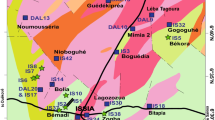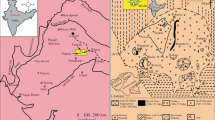Abstract
A magmatic gap from 1.82 to 1.76 b.y. in the Lake Superior region represents the transition from synorogenic calc-alkaline igneous activity of the Penokean Orogeny to anorogenic potassic granophyric granite and ignimbrite. This paper deals with the petrogenetic evolution of 1.76 b.y. granites which represent a major change in source material and conceivably tectonic setting. Although perhaps related to a termination of the Penokean Orogeny by melting of a tectonically thickened crust during collision, these post-Penokean granites may represent the initial appearance of anorogenic, potentially rift-related igneous activity that was widespread throughout North America during late Precambrian time.
These post-Penokean granites are too iron-rich and Al-poor to be considered calc-alkaline, a compositional feature shared with most anorogenic igneous activity of continental regions. Within this suite in central and northern Wisconsin, regional differences in composition indicate at least two different granite magma types: one a metaluminous suite of biotite and biotite-hornblende granite and a peraluminous suite of two-mica granite. The systematic compositional differences (Al, Fe/Mg, Ba/Sr, REE) in the two magma suites are likely the result of small differences in residue mineralogy and/or source composition. In general, the degree of fusion was small (10%) and probably of relatively young Penokean material. Both suites have a range of composition due to feldspar dominated fractional crystallization. Removal of the accessory minerals apatite, zircon, and allanite resulted in the REE depletion with differentiation of the two-mica granites.
The granites intruded into the upper levels of the crust, and the appearance of primary celadonitic muscovite and subsolvus alkali feldspars (silicic members only) in the two mica granites indicate crystallization at depths of 10–11 km. The biotite granites contain both hypersolvus and subsolvus members and are intruded at depths less than 6 km with the more shallow members generating major volumes of ignimbrite. As a marked departure from the characteristics of most anorogenic granites, these melts crystallized at fairly oxidizing conditions (higher for the two-mica suite) as reflected in the composition of biotite, predominance of magnetite over ilmenite, and early appearance of the Fe-Ti oxides in the crystallization sequence.
Similar content being viewed by others
References
Albee AL, Ray L (1970) Correction factors for electron probe microanalysis of silicates, oxides, carbonates, phosphates, and sulfates. Anal Chem 42:1408–1414
Allegre CJ, Trevil M, Minster J, Minster B, Albarede F (1979) Systematic use of trace element in igneous process. Contrib Mineral Petrol 60:57–75
Anderson JL (1980) Mineral equilibria and crystallization conditions in the late Precambrian Wolf River rapakivi massif, Wisconsin. Am J Sci 280:289–332
Anderson JL, Cullers RL (1978) Geochemistry and evolution of the Wolf River batholith, a late Precambrian rapakivi massif in North Wisconsin, USA. Precambrian Res 7:287–324
Aderson JL, Cullers RL, Medaris LG Jr (1977) Evolution and tectonic implications of the rapakivi granite-monzonite-anorthosite suite Wolf River batholith, North Wisconsin, USA. EOS Am Geophys Union Trans 58:534
Anderson JL, Davis GA, Frost EG (1979) Field guide to regional Miocene Detachment Faulting and early Tertiary (?) Mylonitic terranes in the Colorado River Trough, Southeastern California and western Arizona. In:Abbott, PL (ed). Geologic Excursions in the southern California area. San Diego, San Diego State University, pp 108–133
Anderson JL, Rowley MC (1980) Synkinematic intrusion of two-mica and associated metaluminous granitoids, Whipple Mountains, California. Can Mineral (in press)
Arth JG (1976) Behavior of trace elements during magmatic processes — a summary of theoretical models and their applications. USGS J Res 4:41–47
Asquith GB (1964) Origin of Precambrian Wisconsin rhyolites. J Geol 72:835–847
Banks PO, Rebello DP (1969) Zircon ages of a Precambrian rhyolite, northeastern Wisconsin. Geol Soc Am Bull 80:907–910
Banks PO, Van Schmus WR (1972) Chronology of Precambrian rocks of iron and Dickinson Counties, Michigan. Part II, 17th Ann. Inst. on Lake Superior Geol., Houghton, Michigan, 23
Barker F, Wones DR, Sharp WN, Desborough GA (1975) The Pikes Peak batholith, Colorado Front Range, and a model for the origin of the gabbro — anorthosite — syenite — potassic granite suite. Precambrian Res 2:97–160
Bence AF, Albee AL (1968) Empirical correction factors for the electron microanalysis of silicates and oxides. J Geol 76:382–403
Bickford ME, Sides JR, Cullers RL (1980) Chemical evolution of magmas in the igneous terrane of the St. Francois Mountains, Mo., Part I: field, petrographic, and major element data. J Geoph Res (in press)
Bridgwater D, Windley BE (1973) Anorthosites, postorogenic granites, acid volcanic rocks and crustal development in the North Atlantic shield during the Mid-Proterozoic. Spec Publ Geol Soc S Afr 3:307–317
Cain JA (1963) Some problems of the Precambrian geology of northeastern Wisconsin. A review: Ohio J Sci 63:7–13
Chappel BW, White AJR (1974) Two contrasting granite types. Pacific Geol 8:173–174
Chase CG, Gilmer TH (1973) Precambrian plate tectonics — the midcontinent gravity high. Earth Planet Sci Lett 21:70–78
Cullers RL, Chaudhuri S, Kilbane N, Koch RJ (1979) The rare earth contents in different size fractions and whole rocks from Pennsylvanian and Permian platform sediments from the midcontinent of the USA. Geochim Cosmochim Acta 43:1285–1302
Cullers RL, Koch R, Bickford ME 1980 Chemical evolution of magmas in the igneous terrane of the St. Francois Mts., Mo., Part II: Trace element evidence. J Geophys Res (in press)
Dott RLJr, Dalziel IWD (1972) Age and correlation of the Precambrian Baraboo quartzite of Wisconsin. J Geol 80:552–568
Davis GA, Anderson JL, Frost EG, Shackelford TJ (1980) Mylonitization and detachment faulting in the Whipple-Buckskin-Rawhide Mountains terrane, southeastern California and western Arizona. In: Davis GH, Coney PJ, Crittenden M (ed). Metamorphic Core Complexes, G.S.A. Memoir 153 (in press)
Emslie RF (1978) Anorthosite massifs, rapakivi granites, and late Proterozoic rifting of North America. Precambrian Res 7:61–98
Ervin CP, Hammer S (1974) Bouguer anomaly gravity map of Wisconsin. Wisconsin Geological Survey (scale 1∶500,000)
Garrison JR, Long LE, Richmond DL (1979) Rb-Sr and K-Ar Geochronologic and isotopic studies, Llano uplift, Central Texas. Contrib Mineral Petrol 69:361–374
Gates RM (1942) The Baxter Hollow granite cupola. Am Mineral 27:699–711
Gordon GE, Randle K, Goles GG, Corliss JB, Beeson MH, Oxley SS, Gram OE (1968) Instrumental Activation Analysis of standard rocks with high resolution xray detectors. Geochim Cosmochim Acta 32:369–396
Gram OE (1947) Tectonic features of the Utley meta-rhyolite. J Geol 55:427–438
Green JC (1972) Field trip guide book for Precambrian north shore volcanic group northeastern Minnesota. Minnesota Geological Survey, University of Minnesota, St. Paul, 36 p
Greenland LP (1970) An equation for trace element distribution during magmatic crystallization. Am Mineral 55:455–465
Guidotti CV, Cheney JT, Guggenheim S (1976) Distribution of titanium between coexisting muscovite and biotite in pelitic schists from northwestern Maine. Am Mineral 62:438–448
Hanson GH (1978) The application of trace elements to the petrogenesis of igneous rocks of granitic composition. Earth Planet Sci Lett 38:26–43
Haskin LA, Allen RO, Helmke PA, Paster TP, Anderson MR, Korotev RS, Zweifel KA (1970) Rare earths and other trace elements in Apollo 11 lunar samples. Proc Apollo 11 Lunar Sci Conf. Geochim Cosmochim Acta (Suppl 1) 2:1213–1231
Haskin LA, Korotev RL (1977) Test of a model for trace element partition during closed-system solidification of a silicate liquid. Geochim Cosmochim Acta 41:921–939
Hine R, Williams IS, Chappel BW, White AJR (1978) Contrasts between I and S-type granitoids of the Kosciusko batholith. J Geol Soc Aust 25:219–234
Hubbard HA (1975) Lower Keweenawan volcanic rocks of Michigan and Wisconsin. U.S.G.S. J Res 3:529–541
Jacobs JW, Korotev RL, Blanchard DP, Haskin LA (1977) A well tested procedure for instrumental neutron activation analysis of silicate rocks and minerals. J Radioanalytical Chem 40
Koch RJ, Cullers RL, Bickford ME (1978) Petrogenesis of the Precambrian St. Francois Mountains Batholithic complex, Missouri: Trace element evidence. GSA Abstr Progr 10:21
LaBerge GL, Myers PE (1973) Precambrian geology of Marathon County. Special Paper, 19th Annual Inst. Lake Superior Geology guidebook: 31–35
Maase RS, Medaris LG Jr, Van Schmus WR 1980 Penokean deformation in central Wisconsin. GSA Spec Pap (Goldich volume) (in press)
Medaris LG Jr, Anderson JL (1973) Preliminary geological map of Green Bay sheet, Wisconsin. In: Guidebook to the Precambrian geology of northeastern and northcentral Wisconsin. Inst on Lake Superior Geology, 19th Annual Mtg, Madison, Wisconsin (scale 1∶250,000)
Miller CF, Mittlefehldt DW (1979) Rare earth depletion accompanying differentiation of felsic plutonic rocks. GSA Abstr Progr 11:479–480
Miller CF, Stoddard EF, Bradfish LJ, Dollase WA (1980) Composition of plutonic muscovite. Genetic implications. Can Mineral (in press)
Minster JF, Allegre CJ (1978) Systematic use of trace elements in igneous processes, Part III: Inverse problem of batch partial melting in volcanic suites. Contrib Mineral Petrol 68:37–52
Morse SA (1970) Alkali felspars with water at 5 Kb. J Petrol 11:221–251
Mysen BO (1978) Limits of solution of trace elements in minerals according to Henry's law. Review of experimental data. Geochim Cosmochim Acta 42:871–885
Petro WL, Vogel TA (1977) Tectonic setting and major element chemistry of plutonic rock suites. EOS, Am Geophys Union Trans 58:534
Sawkins FJ Widespread continental rifting. Some considerations of timing and mechanism. Geology 4:421–430
Shaw DM (1970) Trace element fractionation during anatexis. Geochim Cosmochim Acta 34:237–243
Silver LT, Bickford ME, Van Schmus WR, Anderson JL, Anderson TH, Medaris LG Jr (1977) The 1.4–1.5 b.y. transcontinental anorogenic plutonic perforation of North America. GSA Abstr Progr 9:1176–1177
Sims PK (1976) Precambrian tectonics and mineral deposits. Lake Superior Region. Economic Geology 71:1092–1127
Smith EI (1975) Chemical characteristics of the Marquette rhyolite, Green Lake County, Wisconsin. GSA Abstr Progr 7:860
Smith EI (1976) Geology and geochemistry of the Precambrian Marcellon rhyolite, Columbia Co., Wisconsin. Proc 22nd Annual Inst Lake Superior Geology 58
Smith EI (1978) Precambrian rhyolites and granites in south central Wisconsin: field relations and geochemistry. Geol Soc Am Bull 89:875–890
Stark JT (1932) Igneous rocks in the Baraboo District, Wisconsin. J Geol 40:119–139
Steiger RH, Jäger E (1977) Submission on geochronology-convention on the use of decay constants in geo- and cosmochronology. Earth Planet Sci Lett 36:359
Stewert JH (1976) Late Precambrian evolution of North America: Plate Tectonics implication. Geology 4:11–15
Streckeisen A (1976) To each plutonic rock its proper name. Earth Sci Rev 12:1–33
Van Schmus WR (1975) Early and middle Proterozoic history of the Great Lakes area, North America. Philos Trans R Soc London Sep A 280:605–628
Van Schmus WR (1980) Chronology of igneous rocks associated with the Penokean Orogeny in Wisconsin. GSA Spec Pap (Goldich Volume) (in press)
Van Schmus WR, Anderson JL (1977) Gneiss and migmatite of Archean Age in the Precambrian basement of central Wisconsin. Geology 5:45–48
Van Schmus WR, Medaris LG, Banks PO (1975) Chronology of Precambrian rocks in Wisconsin, I: The Wolf River Batholith, a rapakivi massif approximately 1,500 m.y. old. Geol Soc Am Bull 86:907–914
Van Schmus WR, Thurman EM, Peterman ZE (1975) Geology and chronology of Precambrian rocks in Wisconsin, II: Rb-Sr data for the older rocks in Eastern and Central Wisconsin. Geol Soc Am Bull 86:1255–1265
Whitney JA, Stormer JC Jr (1977) The distribution of NaAlSi3O8 between coexisting microcline and plagioclase and its effect on geothermometric calculations. Am Mineral 62:687–691
Wones DR (1979) Intensive parameters during crystallization of granitic plutons. GSA Abstr Progr 11:543
Wones DR, Eugster HP (1965) Stability of biotite: experiment, theory, and application. Am Mineral 50:1228–1278
Author information
Authors and Affiliations
Rights and permissions
About this article
Cite this article
Anderson, J.L., Cullers, R.L. & Van Schmus, W.R. Anorogenic metaluminous and peraluminous granite plutonism in the mid-proterozoic of Wisconsin, USA. Contr. Mineral. and Petrol. 74, 311–328 (1980). https://doi.org/10.1007/BF00371700
Received:
Accepted:
Issue Date:
DOI: https://doi.org/10.1007/BF00371700




